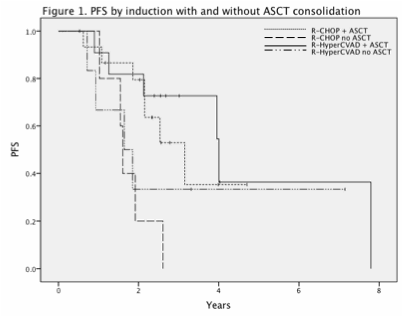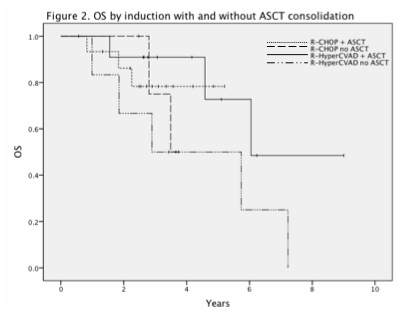Abstract
Mantle cell lymphoma (MCL) is a disease of older adults with median age at diagnosis of over 60. While receipt of high-dose chemotherapy with autologous stem cell transplant (ASCT) consolidation has been shown to improve progression free survival (PFS) following standard induction chemo-immunotherapy in younger patients, the benefit of ASCT consolidation in older patients remains uncertain. To address this, we evaluated the benefit of ASCT in a cohort of older patients with MCL treated at our center.
Patients age over 60 diagnosed with MCL and treated at the University of Pennsylvania between January 2003 and June 2012 treated with R-CHOP or R-HyperCVAD induction and deemed fit for ASCT at the completion of induction were analyzed. Induction regimen was chosen based on treating physician and/or patient preference. PFS was defined as time from initiation of therapy to radiographic or biopsy proven progression or death in remission, and overall survival (OS) was defined as time from diagnosis to death from any cause. Response assessments were performed at the discretion of the treating physician.
Thirty-eight patients were identified: 20 (53%) received R-CHOP induction and 18 (47%) received R-HyperCVAD. Baseline patient and disease-related characteristics were similar between groups (Table 1). With R-CHOP, patients received a median of 6 cycles of chemotherapy including mobilization (range 6 to 8). With R-HCVAD, patients received a median of 8 (A or B) cycles including mobilization (range 5 to 8). Adverse events requiring hospitalization or a change in dose or timing of therapy occurred in 67% of R-CHOP and 84% of R-HyperCVAD patients (p=0.27). The most common adverse event was neutropenic fever/infection (15 patients). Significantly more patients undergoing R-HyperCVAD induction required red cell or platelet support (17 [100%] vs 9 [64%], p=0.012). Thirteen patients (72%) completed all cycles of R-HyperCVAD. Three patients (16%) were converted to R-CHOP because of toxicity. Patients who completed at least cycle 2B were included in the R-HyperCVAD group for analysis. Complete response was achieved in all but one patient in each induction group.
Baseline characteristics by induction chemotherapy
| . | R-CHOP (n=20) . | HyperCVAD (n=18) . | Overall (n=38) . | P-Value . |
|---|---|---|---|---|
| Median Age At Treatment | 66 | 64 | 65 | 0.745 |
| Stage 3/4 | 19 (95%) | 18 (100%) | 37 (97%) | 1.0 |
| ECOG Performance Status 0/1 | 17/17 (100%) | 14/14 (100%) | 31/31 (100%) | 1.0 |
| Median MIPI Score | 6 | 5.9 | 5.9 | 0.659 |
| LDH Elevated | 3/16 (19%) | 3/11 (27%) | 6/27 (22%) | 0.662 |
| Marrow Disease | 12/16 (75%) | 14/17 (82%) | 26/33 (79%) | 0.688 |
| Extra Nodal Disease | 18/20 (90%) | 15/18 (83%) | 33/38 (87%) | 0.653 |
| Bulky Disease | 5/19 (26%) | 5/15 (33%) | 10/34 (29%) | 0.781 |
| . | R-CHOP (n=20) . | HyperCVAD (n=18) . | Overall (n=38) . | P-Value . |
|---|---|---|---|---|
| Median Age At Treatment | 66 | 64 | 65 | 0.745 |
| Stage 3/4 | 19 (95%) | 18 (100%) | 37 (97%) | 1.0 |
| ECOG Performance Status 0/1 | 17/17 (100%) | 14/14 (100%) | 31/31 (100%) | 1.0 |
| Median MIPI Score | 6 | 5.9 | 5.9 | 0.659 |
| LDH Elevated | 3/16 (19%) | 3/11 (27%) | 6/27 (22%) | 0.662 |
| Marrow Disease | 12/16 (75%) | 14/17 (82%) | 26/33 (79%) | 0.688 |
| Extra Nodal Disease | 18/20 (90%) | 15/18 (83%) | 33/38 (87%) | 0.653 |
| Bulky Disease | 5/19 (26%) | 5/15 (33%) | 10/34 (29%) | 0.781 |
After R-CHOP induction, 15 (75%) patients underwent ASCT. After R-HyperCVAD, 6 (33%) patients underwent ASCT. The most common reasons for not undergoing ASCT were physician recommendation (6 patients, 35%) and patient preference (5, 29%). Rates of adverse events were similar during ASCT after R-CHOP (9, 60%) or R-HyperCVAD (3, 50%). There was no ASCT associated mortality. Among those not transplanted, after R-HyperCVAD 6 (50%) received rituximab maintenance and none did after R-CHOP.
With a median length of follow-up of 2.7 years, median PFS was 2.6 years and median OS was 6.0 years. Kaplan-Meier plots for PFS are shown in Figure 1. Patients treated with R-CHOP+ASCT and R-HyperCVAD alone both had longer PFS than patients treated with R-CHOP alone (median PFS 3.2 vs 1.6 years, p=0.019 and 4.0 vs 1.6 years, p=0.009 respectively). Patients undergoing R-CHOP + ASCT had similar PFS compared to R-HyperCVAD alone (p=0.525). No significant differences in OS survival were found (Figure 2).
Among patients age over 60 eligible for ASCT in primary MCL, ASCT prolonged PFS after R-CHOP induction and resulted in similar PFS to that seen with R-HyperCVAD. Our results suggest that fit older patients with MCL benefit from chemotherapy with either R-CHOP+ASCT or R-HyperCVAD, and that the former regimen may be preferable due to lower rates of toxicity and need for transfusion support. These findings should be confirmed prospectively.
No relevant conflicts of interest to declare.
Author notes
Asterisk with author names denotes non-ASH members.



This feature is available to Subscribers Only
Sign In or Create an Account Close Modal